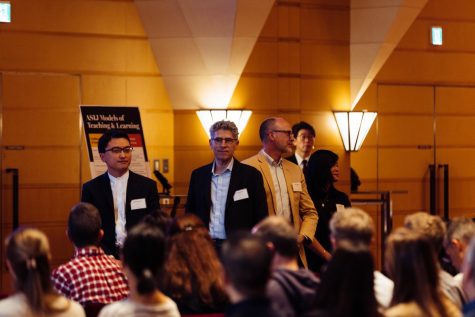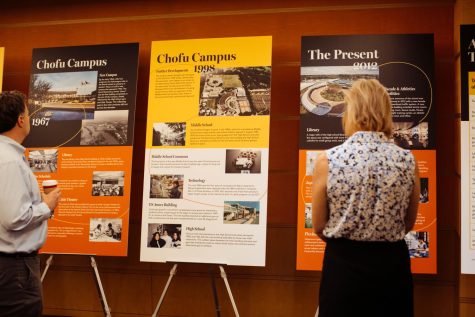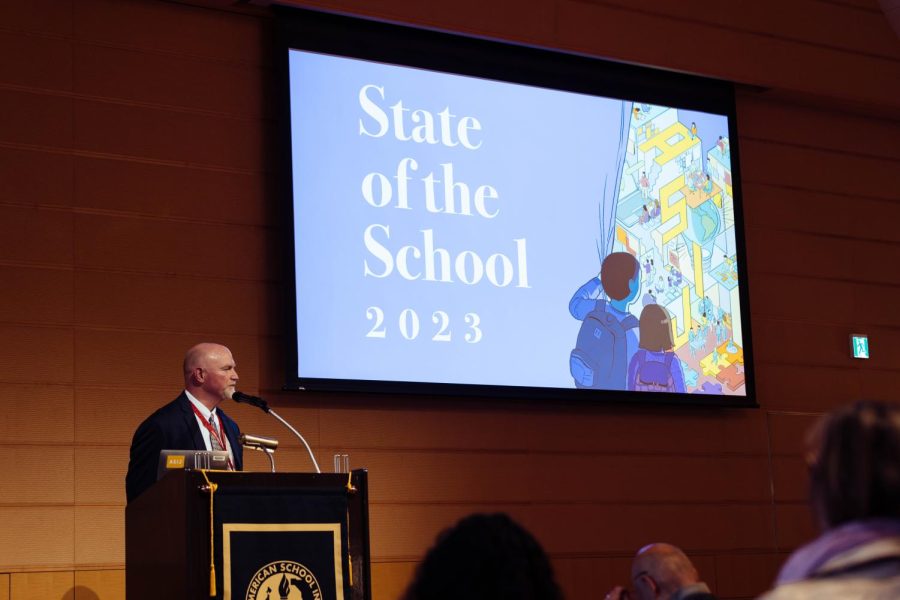Deep Learning Shines at ASIJ’s State of the School
May 30, 2023
On April 27, ASIJ hosted their State of the School at the Tokyo American Club. While the construction of ASIJ’s new Chofu campus was perhaps the most anticipated part of the event, the most persistent theme throughout the day was “Deep Learning,” ASIJ’s still relatively new learning framework.
The event began with a brief introduction by Dr. Hardin, our head of school, whose words were a preface to the event’s central theme. In reference to the proposed campus renovations, he mentioned a desire to create “facilities that drive and inspire ASIJ’s new vision.” This vision includes a new learning framework and a focus on community-based learning. To conclude his speech, Dr. Hardin posed a question: “What skills or competencies will our students need to be successful and happy in 2040 or 2050?”
For me, Dr. Hardin’s introductory words set up a conceptual framework for the rest of the event and gave me some food for thought. Being a student on the Chofu campus, I had certainly been excited to see a digital rendering of the redesigned school, but I had never known or considered the pedagogy behind the new facilities. While I had thought that the physically old buildings needed a replacement, I later came to learn how little I had really thought about the use of space.
Before the Ennead architects spoke about the new Chofu campus, event attendees went into three breakout rooms, each focusing on a selection of the Deep Learning experiences of ASIJ students across all divisions. I attended the room on critical thinking. The presentation began with a video of the ELC in Roppongi, where students transformed the drama center into a doctor’s office called the Shiny Seahorse Clinic. The children worked together to plan the clinic, and created a procedural, systemic way of receiving and diagnosing patients. They invited parents who are doctors to the clinic in order to receive insight into patient care and the medical field. According to the Director of the Early Learning Center, Christy Carillo, the children practiced critical thinking by collaborating to figure out the best course of treatment when a patient had a sickness. There was also a strong emphasis on student-centered learning, as opposed to teacher-centered.
Elementary school students subsequently presented “Thinking About Systems,” in which they discussed units on the rice paddy, debate, and body systems. The focus of these three units was understanding how different components of a complex system interact with one another. The students testified that they learned how to “make connections” and “identify patterns,” through activities such as collecting data to improve their rice paddies and make them more productive, annotating articles to craft an argument for their debates, and measuring heartbeat and oxygen levels to get tangible experience that would help them better understand their bodies.
The next project presented was a collaborative effort between the Middle School and High School. It was described as “community-based learning,” reminiscent of Dr. Hardin’s introductory words. Eighth-grade students went to the high school AP Biology and Synthetic Biology classrooms to learn more about CRISPR—the revolutionary gene-editing technology—to get hands-on lab experience. Middle school students testified that “[high school] students are more approachable than teachers sometimes,” and that they could get more individualized attention from the HS students, as they were in small groups of 4-5 people.
Finally, two high school students spoke about the art program at ASIJ and how its structure encourages critical thinking. Senior Hana Ito said that the teacher is more of a facilitator than a lecturer. She added that ASIJ art classes tend to be “less art theory, and not lecture based,” allowing for more flexibility and hands-on work. Junior Erika Kasuga spoke about the merits of having people with varied interests in a single class, such as diversity of opinions, combined synergies to create new works, and more.
 After the breakout rooms, the Ennead architects began their presentation of ASIJ’s new campus. The architects revealed that their goal was to “support ASIJ’s pedagogical aspirations and Portrait of a Learner,” by reinforcing a strong sense of community while planning for increased enrollment, creating a resilient campus that makes ASIJ a leader in sustainability, and establishing a welcoming and inclusive environment. With these goals in mind, the redesign was approached from a humanist, rather than aesthetic perspective. The architects emphasized that the plan shared at the event would act as a template for the future, so that every decision taken from now on would be an intentional step toward the final vision.
After the breakout rooms, the Ennead architects began their presentation of ASIJ’s new campus. The architects revealed that their goal was to “support ASIJ’s pedagogical aspirations and Portrait of a Learner,” by reinforcing a strong sense of community while planning for increased enrollment, creating a resilient campus that makes ASIJ a leader in sustainability, and establishing a welcoming and inclusive environment. With these goals in mind, the redesign was approached from a humanist, rather than aesthetic perspective. The architects emphasized that the plan shared at the event would act as a template for the future, so that every decision taken from now on would be an intentional step toward the final vision.
The Ennead architects then proceeded to identify the problems with the current campus, and addressed how their new designs solved these problems and were better suited to serve a future ASIJ. For instance, they mentioned that the current HS building is undersized, aging, and perhaps most importantly, does not support the modern pedagogy of Deep Learning and ASIJ’s Portrait of a Learner. They went on to say similar things about the MS and ES buildings, with the ES buildings having the additional issue of being separated from other divisions.
Another problem the architects sought to address were the fragmented aspects of ASIJ’s campus. They want the campus to be more cohesive, both in terms of learning and recreational spaces. For instance, their initial survey of the Chofu campus revealed that the greenery in outdoor spaces is disjointed.
The architects had previously met with students on campus, asking them what they would like to change about our campus. During the presentation, they revealed that one ES student responded by saying that they would like a river to flow through campus. The architects joked that while unfortunately, this would not be possible, this idea of a “river” would eventually come to create a metaphor for the new learning facilities of ASIJ.
A question that the architects continuously asked themselves as they took on this project was “How can we support the individual learning journey of a child?” The purpose of redesigning the school is to align the facilities and physical spaces to ASIJ’s new vision. A river is always moving and flowing, and like a river, a learning environment should be adaptable and fluid as such. A river-like learning environment would “give a child a dynamic sense of their own growth and development.” Using this concept of a river, the architects designed a continuous, flowing building that would support all three divisions of the school.
With this idea of a “river” in mind, the architects guided the audience through their conceptual framework of what the building would look like inside. They mentioned that the spaces in between the classrooms are just as important as the classrooms themselves— they need to be “interdivisional, collaborative, and interdisciplinary.” These “in-between spaces” needed to be organized in a way that enhanced the pedagogy of ASIJ, while being flexible enough to accommodate a variety of purposes.
With the learning frameworks of each division of the school in mind, the “in-between” spaces for each division were designed slightly differently. For instance, the ES would have “pods” in which students could learn together. The MS would have larger spaces that support group learning as well as personal agency. The HS would have a large central collaboration area, with flexibility for student-led learning and individual study at the same time. To create a cohesive campus, all these “in-between” spaces would face inward toward the courtyard, the common green space on campus.

While the construction of the new campus will admittedly take a long time, the architects revealed that no one would be displaced. The HS division of the new“river” building would begin first where the current MS field stands, and the buildings would slowly be replaced one by one. Of course, accommodations would have to be made here and there, but no one would be forced to move off the Chofu campus for the duration of the construction.
As a senior about to graduate, it is certainly interesting to observe the ways in which ASIJ has changed over the last couple of years. In the last year, I have become increasingly aware of concepts of Deep Learning and the Portrait of a Learner as they were integrated into my classes and learning space. But I have to admit, I was unaware of ASIJ’s dedication to its new vision and pedagogy until this event.
Again, I am brought back to Dr. Hardin’s opening statement, and as we look into the future of ASIJ— both its curriculum and spaces—I too wonder, “What skills or competencies will our students need to be successful and happy in 2040 or 2050?”





















Lina • Jun 1, 2023 at 8:54 AM
Beautifully written, concise, and to-the-point. I learned so much about this new learning framework and the reasons behind ASIJ’s renovation as well as the architectural choices they made. As a student who has been going to ASIJ since kindergarten, I thought it was a great idea to develop more connection between all divisions.